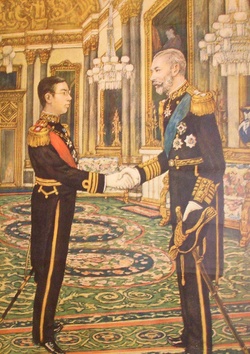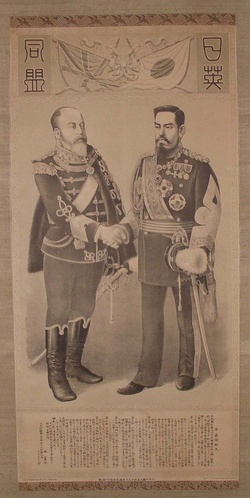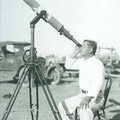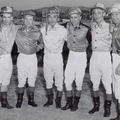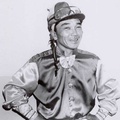7. You have Nisei relatives named Tak, Tad, George, Harry or Shig.
— From 101 Ways To Tell If You’re Japanese American
Of the various male and female names found on Jenny Kuida and Tony Osumi’s terrific 101 Ways… list, none is more iconic of the early Japanese American experience than George. I have two Nisei relatives by that name, one of my father’s brothers and an uncle by marriage; both of them were eldest sons. It had to have been the most popular name for Nisei boys.
The Imperial Valley in Southern California provides just a small sample size, but even there before the war there were well over fifty Nisei named George: Asamen, Hamashima, Higa, Hoshizaki, Imamura, Iwanaga, Kakiuchi, Kanazawa, Kanda, Kawanami, Kawanami, Kimura, Kita, Kobayashi, Kodama, Kohama, Kohatsu, Komatsu, Kubo, Kumagai, Maruya, Matsumoto, Matsuno, Miyagi, Miyashiro, Nakahama, Nakama, Nakamoto, Nakamura, Nakamura, Neeno, Obayashi, Ota, Oyenoki, Sahara, Sakaniwa, Sano, Sasaki, Seriguchi, Taira, Taniguchi, Tokeshi, Tsuchiyama, Uchimiya, Umezawa, Uyeda, Yada, Yamaguchi, and others. The two George Kawanamis were cousins living in the same town!
By comparison, a cursory look for Nisei boys’ names in the 1930 census for Imperial County produced twenty-one Taks, seven Tads, eight Henry/Harrys, and seven Shigs. And it must be remembered that Tak, Tad, and Shig are shortened nicknames for a wide variety of different names.
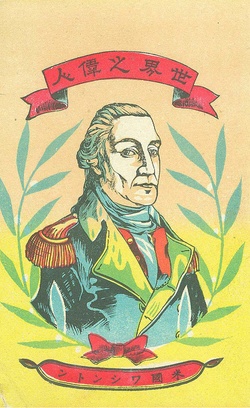
Ask any Nisei named George whom they were named after and more often than not they will say George Washington. I think this was especially true for chōnan (eldest sons). Being the first of a generational series or the first of a dynasty—distinguished as shodai (初代) in Japanese—was an exalted station in Japanese culture. So for the Issei, the name of the first president of the United States was an auspicious name for their firstborn sons.
Moreover, many Issei had learned about George Washington as schoolchildren even before coming to America. The story of a boy who chopped down a cherry tree and could not tell a lie, who then grew up to become commander-in-chief of the Continental Army and president of a new nation was an excellent example for shūshin (moral education) and it had been incorporated into elementary school readers during the Meiji period (1868–1912).
Because of the connection to George Washington, I always believed that by naming a son George the Issei were expressing their desire to assimilate into American society. I am sure this was true for a good number of Issei.
But the majority of Japanese immigrants, like my grandparents, initially intended to follow the dekasegi practice of striking it rich in America and then returning to Japan. So if my grandparents did not think that they were going to permanently stay in the United States, why would they name their firstborn George? Or conversely, if assimilation had been their goal, why did they give their next five children only a Japanese name: Kumiko, Keige, Michiko, Tatsuo, and Masako? Their last child, my aunt May, who was born in 1940 obviously has an American name. By then my grandparents had given up on their dekasegi plan and the older children likely played a role in urging the selection of an American name.
Perhaps the answer lies in the idea that for my grandparents and possibly others, the name was not an American name at all; it was actually a Japanese name, only the Nisei spelled it G-E-O-R-G-E. Phonetically the Issei pronounced it “joe-jee,” and Jōji was a common personal name for boys in Japan. Thus, when writing Japanese, say, in a letter to family back home to announce the birth of their son, Issei parents used kanji characters for Jōji rather than writing George in katakana (as ジョージ) as other American names were written. Two of the most common ways of writing Jōji/George in kanji are 譲治 and 貞治. Other renderings include 譲司 and 襄志. My grandparents selected more obscure characters for my uncle George’s name: 定治 (which typically would be read as Sadaharu).
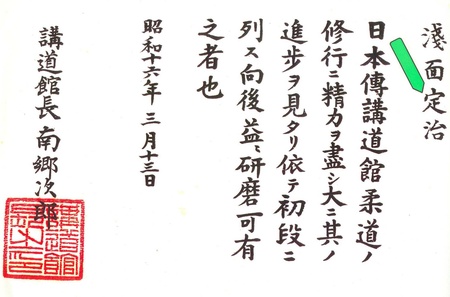
Incidentally, the duality of Jōji/George mirrored the Nisei generation’s dual citizenship, a status they held until the end of 1924. Nisei were American citizens by birth, but in accordance with Japanese law they were also citizens of Japan—regardless of where they were born—by virtue of their parents’ Japanese citizenship. For those Issei who had their children’s names entered into their family koseki (household registry) in Japan, thereby confirming their Nisei offsprings’ Japanese citizenship, it was ideal for them to have a Japanese name. The English alphabet was not permissible and for boys’ names kanji was more appropriate than kana.
The Nisei’s dual citizenship drew fire from the anti-Japanese movement on the West Coast, which spurred Issei leaders to implore the Japanese government to amend its nationality code. Japan’s lawmakers complied, and effective December 1, 1924, Nisei were no longer automatically citizens of Japan. However, Issei parents could still register their children as Japanese citizens at Japanese consular offices within fourteen days of their birth. The change in Japan’s nationality code also made it possible, and simple, for those Nisei born prior to December 1, 1924, and those registered afterward, to renounce their Japanese citizenship at any time.
There is an interesting and probably little known facet of the name. Not all Nisei named George were the namesake of our nation’s Founding Father. In Brawley, California, for example, a doctor named Dunham delivered Dosho and Maka Tokeshi’s first child, a son, in 1919. Dr. Dunham was an Englishman and he explained to the proud, new parents that it was the custom in England to name the firstborn after the reigning king or queen, that is, the eldest son when the reigning sovereign was a king and the eldest daughter when the reigning sovereign was a queen. Dosho fancied the custom and he named his son George after King George V whose reign began in 1910 and ended in 1936. As it happened, the majority of Nisei were born during that span of time.
As a young girl, family friend Tayeko (Nakamura) Shibahara, was sent to Japan by her parents with the expectation that she would return to America as a Kibei. However, she got stranded in Japan during the Second World War and ultimately stayed there. In a letter to me, Tayeko shared her take on the significance of the name. She, too, mentioned British royalty, but also the Anglo-Japanese Alliance. Tayeko has convinced me that there must be other Nisei like George Tokeshi, albeit not many, who were named for the king of Great Britain.
I do not think that it is entirely farfetched that at least some Issei were drawn to the name’s association with the British king. Being products of Meiji society, many Issei were well aware of the strong historical and cultural connection between Japan and Great Britain. Moreover, in popular culture at the time, the relationship between Japan and Great Britain was personified by images of interaction between the British royal family and Japan’s imperial family.
Because the Issei were quite sensitive to how they were perceived by the larger society, the appeal of a British name may have been influenced by the Anglo-Japanese Alliance of 1902. As the first modern alliance based on equal terms between an Asian nation and a major Western power, it served as a great source of pride for ethnic Japanese around the world.
Whether George or Jōji, whether named after the first president of the United States or a British king, the name is iconic of the early stage of the Nikkei experience. For some it exemplified the immigrant generation’s determination to become American (even when naturalization was prohibited); for others it was a symbol of Japanese culture, which for many Issei was not easily shaken off, or their pride in Japan’s emerging prestige in the world. It also reflected the historically complex citizenship status of Nisei in both the United States and Japan.
For subsequent generations though, it did not have the same significance. While most of us have a Nisei relative named George, how many sansei or yonsei do you know by that name? I only know one sansei named George. He is my cousin, and we always called him Junior because he has the same name as his father. And I know just one yonsei named George. He is the namesake of his Nisei grandfather who was the chōnan of the Kodama family.
Nor does the name seem to have any special meaning among Shin-Issei, post-World War II immigrants from Japan. I have not yet met any children of Shin-Issei named George. I do have friends in Japan though, a young husband and wife couple, who lived in the United States for several years on a temporary work assignment. While here they had two sons. They recently returned to Japan but they are maintaining their children’s American citizenship. They are in fact dual citizens. Because of this, they gave their sons Japanese names that could easily be shortened to American-sounding names in the event that they choose to live in the United States in the future. The older boy is Kenichi (Ken). They named their second son, not the firstborn, Jōji (丈侍). They preferred the name for their second son because of the sound of the second syllable. Although they selected a different kanji character, -ji written as 二 or 次 denotes a second-born son. What is more, in their mind Jōji does not correspond to George. They say that when Jōji is in the United States he will go by Joe!
According to a Wall Street Journal article “What Baby Name Trends Say About Culture” (July 17, 2015) by Jo Craven McGinty, the rise and fall in the popularity of certain personal names are markers of cultural evolution. The name George definitely shows that Nikkei culture has evolved indeed.
© 2016 Tim Asamen


